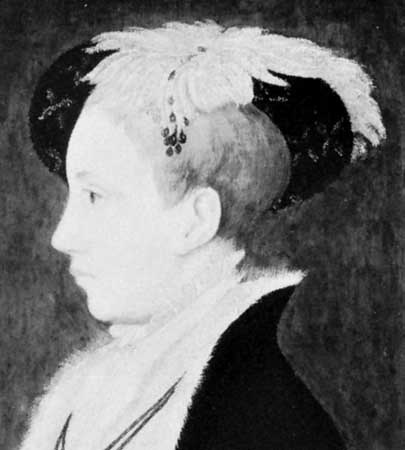Edward VI
king of England and Ireland
born Oct. 12, 1537, London
died July 6, 1553, London
 king of England and Ireland from 1547 to 1553.
king of England and Ireland from 1547 to 1553.Edward was King Henry VIII's only legitimate son; his mother, Henry's third wife, Jane Seymour, died 12 days after his birth. Although Edward has traditionally been viewed as a frail child who was never in good health, some recent authorities have maintained that until several years before his death he was a robust, athletically inclined youth. His tutors found him to be intellectually gifted, a precocious student of Greek, Latin, French, and theology. On Jan. 28, 1547, Henry VIII died and Edward succeeded to the throne.
 Henry had decreed that during Edward's minority the government was to be run by a council of regency; in fact, Edward's uncle, Edward Seymour (Somerset, Edward Seymour, 1st duke of, Baron Seymour of Hache), duke of Somerset (Somerset, Edward Seymour, 1st duke of, Baron Seymour of Hache), wielded almost supreme power as regent, with the title of protector, until he was overthrown in 1549 by the unscrupulous John Dudley (Northumberland, John Dudley, duke of, earl of Warwick, Viscount Lisle, Baron Lisle), earl of Warwick (soon to be duke of Northumberland (Northumberland, John Dudley, duke of, earl of Warwick, Viscount Lisle, Baron Lisle)). The young king was the mask behind which Northumberland controlled the government. The measures taken by both Somerset and Northumberland to consolidate the English Reformation, however, agreed with Edward's own intense devotion to Protestantism.
Henry had decreed that during Edward's minority the government was to be run by a council of regency; in fact, Edward's uncle, Edward Seymour (Somerset, Edward Seymour, 1st duke of, Baron Seymour of Hache), duke of Somerset (Somerset, Edward Seymour, 1st duke of, Baron Seymour of Hache), wielded almost supreme power as regent, with the title of protector, until he was overthrown in 1549 by the unscrupulous John Dudley (Northumberland, John Dudley, duke of, earl of Warwick, Viscount Lisle, Baron Lisle), earl of Warwick (soon to be duke of Northumberland (Northumberland, John Dudley, duke of, earl of Warwick, Viscount Lisle, Baron Lisle)). The young king was the mask behind which Northumberland controlled the government. The measures taken by both Somerset and Northumberland to consolidate the English Reformation, however, agreed with Edward's own intense devotion to Protestantism.In January 1553 Edward showed the first signs of tuberculosis, and by May it was evident that the disease would be fatal. Working with Northumberland, he determined to exclude his two half-sisters, Mary and Elizabeth, from the succession and to put Northumberland's daughter-in-law, Lady Jane Grey (Grey, Lady Jane), and her male heirs in direct line for the throne. As a result, a power struggle erupted after Edward's death. Lady Jane Grey ruled for nine days (July 10–19, 1553) before she was overthrown by the more popular Mary I (reigned 1553–58).
Edward displayed a potential for effective administration, but many scholars have felt that, had he lived, his religious zeal and extreme obstinacy might have imprinted a much firmer and more uncompromising Protestantism on the Church of England.
Additional Reading
The best recent biography is Jennifer Loach, Edward VI, ed. by George Bernard and Penry Williams (1999); but Diarmaid MacCulloch, Tudor Church Militant (1999; also published as The Boy King, 2001), is a more penetrating look at the king as well as the reign.
- Shang Kexi
- Shangluo
- Shangqiu
- Shangrao
- Shangri-La
- Shang Yang
- Shanhaiguan
- Shania Twain
- Shanidar
- Shani Davis
- Shankar Dayal Sharma
- Shankar, Ravi
- Shankar, Uday
- Shan language
- Shannon, Claude
- Shannon, Del
- Shannon, River
- Shannon Wells Lucid
- Shan Plateau
- Shansi
- Shantiniketan
- Shantou
- Shantou wares
- Shantung
- shanty